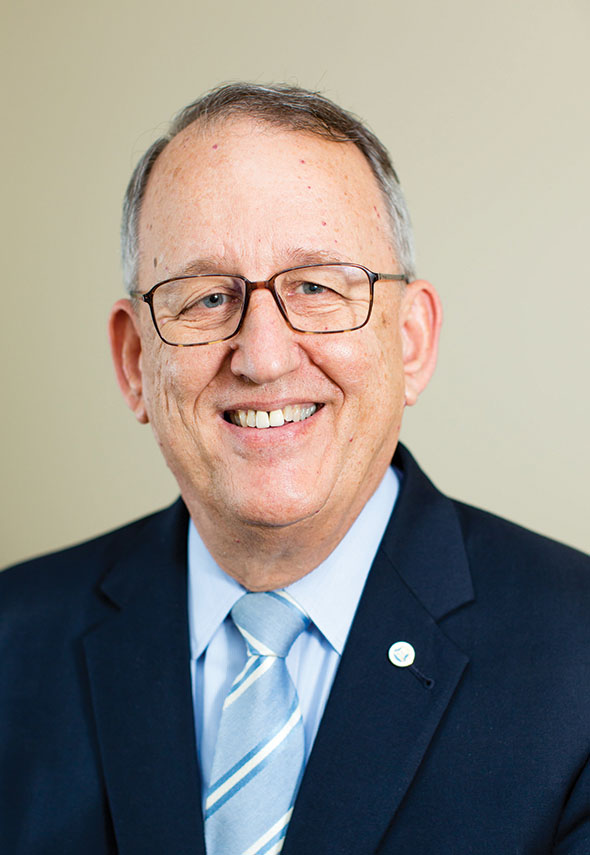On the Occasion of a Quasquicentennial
Posted on Sept. 12, 2018Carolina has long taken great pride in being our nation’s first public university. Many will remember our monthslong bicentennial observance that climaxed on University Day, Oct. 12, 1993, and as we approach University Day 2018 and UNC’s 225th anniversary, there is much that is worthy of note from the past 25 years.

Douglas S. Dibbert ’70
In fall 1993, C.D. Spangler Jr. ’54 was at the beginning of his seventh year as the UNC System’s second president. (He was followed by Molly Broad, Erskine Bowles ’67, Tom Ross ’75 (JD) and Margaret Spellings.) Paul Hardin was beginning his fifth year as Carolina’s seventh chancellor. (Hardin was followed by Michael Hooker ’69, James Moeser, Holden Thorp ’86 and Carol Folt.)
Since 1993, two UNC faculty members have earned Nobel Prizes, and the Carolina Covenant Scholars as well as the Robertson Scholars programs have been launched. In that time, 17 Carolina students have been selected as Rhodes Scholars.
In 1993, North Carolina voters passed the University System Improvement Bonds referendum, which brought $35 million to our campus, funding a new building for Kenan-Flagler Business School and additions to the School of Dentistry and the Lineberger Comprehensive Cancer Center, among other long-needed projects.
In 2000, North Carolina voters passed the $3.1 billion Higher Education Improvement Bonds referendum, and more than $500 million of public funds for our campus prompted nearly $2 billion of much-needed renovations and capital construction. It also is comforting that during that building boom, we took 20 acres of asphalt and converted 10 of those acres into green space. In 2004, the N.C. General Assembly invested $180 million to build the N.C. Cancer Hospital and an additional $50 million was appropriated to establish the University Cancer Research Fund.
Carolina now raises more philanthropic gifts in one year than were raised throughout the six years of the Bicentennial Campaign. And today we are inspired by the ambitious $4.25 billion “For All Kind: The Campaign for Carolina,” which already has achieved half of its goal.
In Carolina’s first 200 years, our athletic teams — women’s soccer, men’s basketball and lacrosse and women’s field hockey — won 17 national championships. Today, Carolina has nine coaches who have coached one or more UNC teams to national championships, and Carolina has won 29 national championships since 1993.
Unfortunately, not all of what has happened at Carolina over the past quarter of a century has brought joy and celebration. Five students perished in a fraternity house fire on Commencement morning in 1996. Michael Hooker succumbed to cancer before concluding his fourth year as chancellor. The world was shocked and shaken by the 9/11 attacks, and six Carolina alumni died in the terrorists’ assaults. We were stunned in March 2008 by the brutal murder of one of Carolina’s most remarkable students — student body president Eve Carson ’08 — and again in February 2015, when three Muslim students were shot to death near our campus, including UNC dental student Deah Barakat ’17 and his wife, Yusor Abu-Salha, who had been admitted to enter the dental school that fall. And we have shared disappointment and embarrassment by the NCAA’s yearslong investigations.
Also since our bicentennial, we’ve mourned the loss of the UNC System’s first president, William Friday ’48 (LLB), and in July, the death of his successor, Dick Spangler, as well as the deaths of, along with Michael Hooker, former UNC chancellors Paul Sharp, Carlyle Sitterson ’31, Ferebee Taylor ’42, Christopher Fordham ’47, William Aycock ’37 (MA, ’48 JD) and Paul Hardin.
Over the past quarter of a century, Carolina has grown both in the size of our campus as well as the number of students, faculty, staff and alumni. Our entering students continue to be remarkably smarter. As awards for research grants become increasingly more competitive, our faculty continues to excel, with annual research spending now exceeding $1 billion. Our entire University is focused on its strategic plan — “The Blueprint for Next”— and its two guiding pillars: “Of the Public, for the Public”; and “Innovation Made Fundamental.”
Born in 1793 during George Washington’s presidency, our alma mater remained open throughout the Civil War, only closing afterward, between 1870 and 1875 due to lack of students and funding. Not receiving state appropriations for buildings until the 20th century, Carolina in 1922 became only the second Southern university invited into membership of the prestigious Association of American Universities. By our 1993 bicentennial, Carolina was perennially ranked among the top five public research universities, and today our alma mater remains a proudly public, global, research university.
Yours at Carolina,

Douglas S. Dibbert ’70
